The famous attractions in Beijing - the Ming Dynasty Tombs (Thirteen Tombs of the Ming Dynasty; Ming Shisanling) were built during 1409-1644. Each held the body of an Emperor, his wives and girlfriends, and numerous funerary treasures. The Tomb area has many stone carvings and palatial buildings, which boast their high historic and cultural value.
Spirit Way
The seven km "spirit way" (or "sacred way") starts with a triumphal arch, then through the Red Gate, where officials had to dismount, and past a giant tortoise (made in 1425) bearing the largest stele in China. This is followed by a guard of 12 set of stone animals. Every second one is in a reclining position, legend has it, to allow for a "changing of the guard" at midnight. Beyond the stone animals are 12 stone-faced human statues - generals, ministers and officials, each distinguishable by headgear. The avenue culminates at the Dragon and Phoenix Gate.
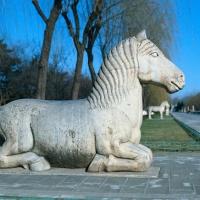

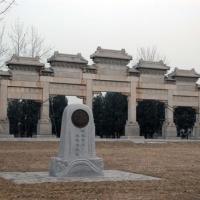
Thirteen of the 16 Ming Emperors are buried in a 40 sq km area at Shisanling but only one tomb, Dingling, has been excavated. Others can be viewed from the exterior like Changling, which was started in 1409 and took 18 years to complete. This is the tomb of the Emperor Yong Le, and so the story goes, 16 concubines who were buried alive with his corpse.
Dingling
Dingling is the tomb of Emperor Wan Li (1573-1620) and is the second largest tomb. It was excavated in 1956-1958 and you can visit the underground passageways and caverns. The emperor used half a million workers, a heap of silver and six years to build his necropolis and then held a wild party inside the complicated chambers. The underground covers 1195 sq meters, entirely built of stone, and sealed with an unusual look stone. The tomb yielded 26 lacquered trunks of funerary objects, some of which are displayed on-site; others have been removed to Beijing Museums and replaced with copies.
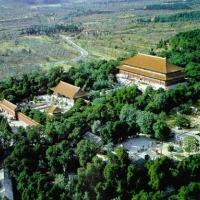
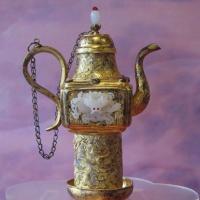

Wan Li and his royal spouses were buried in double coffins surrounded by chunks of uncut jade- the jade was thought to have the power to preserve the dead, or could have bought millions of bowls of rice for starving peasants, so the Chinese tour literature relates. Meanwhile cultural relics experts as well as chefs are studying the ancient cookbooks unearthed from Dingling with a view to serving Wan Li's favorite dishes to visitors, using replicas of imperial banquet tableware.
Until they figure that one out, you might have to content yourself with the amusing cardboard cut-outs and other props used by Chinese photographers at the site.
Changling
The first built of the 13 tombs, the Changling Tomb buried the Ming Emperor Yongle and his empress Xu. It was the largest (occupying 10 hectares), most advanced and best preserved imperial mausoleum, using the best materials. Built in 1409, even the underground palace of the massive project took four years to complete. Having undergone the weathering of 600 years, the Changling remains intact and resplendent and magnificent.
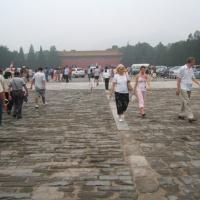
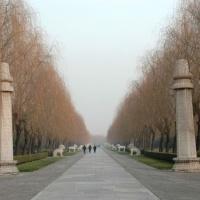
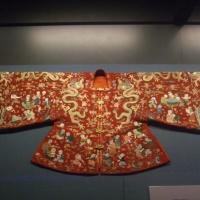
Its design followed that of Xiao Mausoleum for Emperor Zhu Yuangzhang the dynasty founder: the front is a rectangular courtyard and the rear is the round Treasure Dome (tomb mound), led in by 15km Divine Avenue from south to north. The Divine Avenue extends from the stone mausoleum palace as the axis of the entire mausoleum and the symbol of the supreme majesty of the monarch.
Northward from the stone archway along the Divine Avenue are arranged in order the Big Red Gate, Stele of Achievements and Virtues, Watch Post, and stone animals and figures, the line ending at an exquisite and unique Lingxing Gate, the entrance to the mausoleum proper.
Zhaoling
Similarly structured with other mausoleums, Zhaoling is noted for its unique grave mound. Earth was heaped over the grave mound from the drains inside Baocheng of other six mausoleums including Xianling and Kangling. The grave mound of Zhaoling, however, was nearly equal in height to the city wall of Baocheng. On this account, special enclosed wall was built to protect the grave mound. Coupled with the city wall of Baocheng, the enclosed wall formed a closed courtyard, referred to as Mute Courtyard by later generations. The later-built Qingling, Deling and imperial mausoleums of Qing Emperors followed this practice.
The Ming tombs lie in 50 kilometers north-west of Beijing and four kilometers from Changping District, Beijing. The tour buses usually combine them with a visit to the Great Wall. You can also get there on the local buses.
